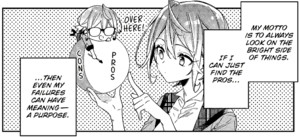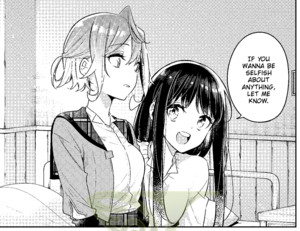The Spring 2025 Manga Guide
The Anemone Feels the Heat
What's It About?

The Anemone Feels the Heat has a story and art by Ren Sakuragi, with English translation by Mei Amaki. This volume is lettered by Rebecca Sze. Published by Yen Press (April 1, 2025). Rated T.
Is It Worth Reading?
Dee
Rating:

This “girl-meets-girl” romantic comedy has plenty of bright points, but its decision to give Mashiro a vague, undefined health condition she needs to “overcome” dampens a lot of the charm for me.
There are sincere moments here that feel true to life, such as Mashiro having good days and bad days, or her wanting to keep her condition a secret because other people's consideration feels more like condescension. But it's counterbalanced by Nagisa's belief that Mashiro just needs a positive attitude and more exercise, as if midday exhaustion is a common symptom for teens who don't jog enough.
If Mashiro had an actual diagnosis, even an invented one, it wouldn't bother me so much. For example, if she were recovering from an illness or injury, then the idea that she needs to build stamina would make sense. But because she's vaguely described as “frail”—and because the narrative never challenges Nagisa's naive understanding of chronic conditions—it creates this generic disability metaphor with the unpleasant implication that “people who aren't healthy just aren't trying hard enough.” I don't think this is intentional, given how sympathetic the narrative is to Mashiro overall, but it's still there, and I could never quite get the sour taste out of my mouth.
When Anemone isn't accidentally falling into wellness grifter rhetoric, this is an enjoyable YA rom-com about two girls hanging out and working through their feelings. The art is appealing (if not particularly remarkable); the panels are easy to follow; and the story clips along at a balanced pace, giving its characters space for internal strife, romantic tension, and a bit of chibi goofiness without dragging out any scene for too long.
As a prospective romantic couple, Nagisa and Mashiro have an engaging back-and-forth: Nagisa inspires Mashiro not to fall into despair, while Mashiro encourages Nagisa to have a social life on top of her studies. Outside of the health storyline, the central conflict seems to be about what each girl means when they say they “like” the other, and figuring that out will likely be the focus of future volumes.
While The Anemone Feels the Heat's handling of chronic health conditions kept me at arm's length, my feelings about this manga still veer closer to “like” than “dislike.” I won't be actively seeking more volumes, but if it turned up at my library, I'd check it out. I wouldn't recommend this one to everyone, but if you like teen yuri rom-coms and aren't fussed by clumsy disability narratives, you may have a good time here.
Rebecca Silverman
Rating:

There's one very off-putting aspect of what is otherwise a very nice story about two girls exploring what “love” means to them: the specter of ableism. It's not even really a “specter” so much as a regular piece of the story; Mashiro, one of the heroines, is “frail,” which seems to translate to some sort of chronic condition. The condition remains unspecified and unnamed throughout the volume, but we're shown that she often collapses, has very little stamina, and gets dizzy. While I appreciate that this doesn't turn into a Sad Sick Girl Romance (or at least, it hasn't yet), the attitude that both Mashiro and Nagisa have towards her condition is “if you try hard, you can get better.” Since that's emphatically shown not to be the case, or even a possibility, this element of the story sticks in my craw as it perpetuates the myth that ill people just aren't trying hard enough to get better.
There is a potential reason for this attitude in the introductory volume, which is that both Nagisa and Mashiro must learn to accept that some things are just always going to be out of reach or difficult. This dovetails with the way both girls ended up at their decidedly mid-high school in the first place: Mashiro collapsed on her way to an entrance exam, and Nagisa found her and took her to the hospital. There was nothing either of them could do about this, and that's something Nagisa, who has always prided herself on her academic genius, is having a very hard time coming to terms with. A piece of her blames Mashiro for collapsing in the first place, and this gets in the way of their budding relationship. Mashiro knows she has a crush on Nagisa, but Nagisa finds that she's having a hard time returning those feelings, even though a piece of her really wants to.
That's the heart of the story right there: the gentle exploration of how a relationship can begin. It's also the volume's greatest strength, with Nagisa trying very hard to overcome her prickly feelings not because she feels she has to, but because she wants to. Mashiro is all girlish charm and bubbly feelings, and Nagisa isn't sure what to do with that; her life has previously been all about study. She's tried to distance herself from that with a new, bleached hairstyle and contacts, but it's much easier to change the outside than the inside. From this angle, and with its soft art (something about the way the creator draws legs is really appealing), The Anemone Feels the Heat has the potential to grow into a better story than this volume implies. It's probably worth a second volume to find out.
Lauren Orsini
Rating:

This manga's weird title gets an explanation in the translation notes. In flower language, an anemone can represent “fleeting love,” “true love,” or “the pain of love.” This story, about one girl who isn't sure if she hates or is in love with the other, makes me think it's the third meaning. The Anemone Feels the Heat is a slow-burning, highly trope-dependent high school romance focusing more on gentle moments rather than flying sparks. The story has pretty art featuring glossy hair and cutesy school uniform, making it feel like classic yuri. But one character's delicate constitution and the other's stubbornness mean hardly anything in this volume differentiates their romance from a run-of-the-mill friendship.
Nagisa is on her way to take her high school entrance exam when she sees a girl collapsed on the street. Mashiro is fine thanks to Nagisa's help, but the delay causes Nagisa to miss her exam and shifts the entire trajectory of her life. She ends up attending the same school as Mashiro—a far less competitive one than Nagisa was aiming for, and now the studious girl is boiling over with resentment. How else can she explain the way her heart beats faster when Mashiro is around except fury? But as the girls get to know one another, Nagisa realizes that being mad at Mashiro is like being mad at a three-legged puppy named Li'l Brudder. Mashiro has a delicate constitution and spends more time in the nurse's office than not. Nagisa tells herself she just wants to help Mashiro get stronger, but is that all this is? Nagisa's treading the water of that famous Egyptian river, Denial, but Mashiro's kittenish defenselessness might be just the thing to bring down her walls.
My biggest issue with this story was the way Mashiro's delicacy was portrayed as a matter of willpower. “You want to change, don't you?” Nagisa asks Mashiro, encouraging her to get stronger. I'll be sure to tell everyone I know with a chronic illness that they just need to get into the 'grindset'. Her weakness makes for plenty of opportunities to snuggle in the conveniently vacant nurse's office, but it feels more like a plot device than a real portrayal of what it's like to live with a chronic condition. By the end of the volume, the girls have hugged and ambiguously admitted they like each other, but it was hard to tell what made them different than gal pals. The art is pretty and the characters are cute, but there's not a lot of substance to be found.
Disclosure: Kadokawa World Entertainment (KWE), a wholly owned subsidiary of Kadokawa Corporation, is the majority owner of Anime News Network, LLC. Yen Press, BookWalker Global, and J-Novel Club are subsidiaries of KWE.
discuss this in the forum (28 posts) |
back to The Spring 2025 Manga Guide
Seasonal homepage / archives